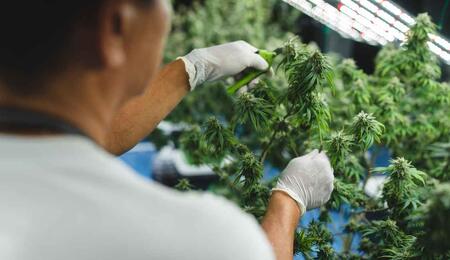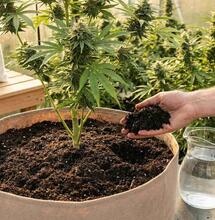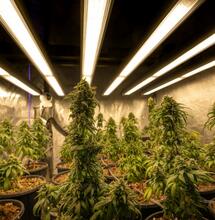All You Need to Know About Super Cropping Cannabis

Super cropping is one of many cannabis plant training techniques that can be applied to plants to help increase yields. If you are new to growing cannabis, you may not have heard about super cropping or how beneficial it can be to your plants.
In this article, I explain everything you need to know about this plant training technique, covering when to super crop your plants, how super cropping works, the tools and equipment required, and the healing time needed. As well as my top tips to help you become a pro at super cropping and get the most significant yields possible.
How Does Cannabis Super Cropping Work?
The first thing you should know about super cropping is that it is classified as a high-stress technique. You may have heard about low-stress training, which involves tying your plants down to produce a more bushy and laterally dominant plant. Super cropping is one of the most stressful techniques and requires a lot more time to heal.
Super cropping involves breaking part of the side branches of your plant and inflicting enough pressure using your fingers to pop the inner cell walls, causing them to break and snap. The broken part will repair itself with a hard wooden knuckle to strengthen the cell walls.
When Is the Right Time to Apply the Super Crop Technique on your Cannabis Plant
You should only apply the super crop technique when your plants are around 5 weeks old and tough enough to withstand the stress and fully recover. You do not want to super crop immature and weak plants to avoid potential injury and long-term damage, and you certainly do not want to super crop a flowering cannabis plant, as this may risk high levels of stress.
The Benefits of Super Cropping
- Super cropping produces tough wood plants.
- Plants will produce growth hormones, resulting in faster growth.
- Super-cropped plants are capable of yielding significantly more.
- The technique is easy to do and does not require tools or equipment.
- You can combine the super crop technique with LST simultaneously.
- Side branches become more resistant and can hold more weight.
Can You Super Crop More Than Once?
The short answer is yes! As long as the vegetation stage is long enough (6-9 weeks), you can apply the super cropping technique on multiple branches over the growing phase. It is advised to super crop only one or two side branches per week, allowing the plants to fully recover and minimise the amount of stress inflicted on them.
Which Are the Best Cannabis Plants for Super Cropping
All cannabis plants are ideally suited for the super crop technique. As long as the plant is healthy, robust and mature enough, then you do not have to worry about what the genetics of the plant is.
Can You Super Crop Autos?
Due to autos having a shorter vegetative period of 4 weeks, you will want to be very careful when applying this technique to autos. Some autos may end up growing short or potentially becoming stunted.
This does not mean that when growing autoflowers, you cannot train them as you would with photoperiods; however, be very careful, as the time you have to train them is very limited. Any high-stress techniques should be avoided after the first week of passing.
How Much Time Do Plants Need to Heal After Super Cropping
Give your plants 5-7 days to fully recover before attempting to apply the super crop technique again. The main reason is recovery time, allowing the plants to utilise the growth repair hormone to form a hard, wooden knuckle that supports the break. Once your plant has fully recovered, you can apply the technique again to other side branches.
What Tools and Equipment Are Needed for Super Cropping
Unlike other plant training techniques that typically require a sharp pair of scissors, a scalpel or gardening wire, you only need a pair of hands. The method works by using your finger and thumb to forcefully twist and squeeze until the cell walls break under pressure. The technique only takes seconds to do when done correctly.
My Top Tips for Super Cropping Your Plants
Mastering the super cropping technique requires time and considerable practice. Below are my top tips to consider before you attempt to super crop your plants.
Tip #1: Only work with healthy plants
It is critical that you only work with healthy and mature plants. The reason is that unhealthy or weak immature plants will not respond well to the side branches being purposely snapped. I have had incidents in the past where certain plants were severely damaged, the side branch had to be cut off, or they did not heal properly, creating a worst-case scenario.
Tip #2: Give plants time to recover
I have found over the years that the side branches will take around 5-7 days to form a hard knuckle to support the break. That does not mean all plants will bounce back and recover within that time, and some may take up to 10 days. My tip here is to pay close attention to your plants once they have been super cropped and avoid causing any more stress in the meantime.
Tip #3: Support the side branches with canes
One great way to help support the side branches once you have super-cropped them is to use wooden canes and tie the side branches to them. The canes should be inserted into the side of the pots to avoid damaging the roots. Doing so will help the healing process and keep the plant well supported during the recovery phase.
Tip #4: Accidents can happen
In a worst-case scenario, some side branches may not be able to withstand the pressure and snapping motion caused by super cropping, especially in weaker plants. Be prepared to cut away the damaged side branch that is unable to recover. In some cases, you will see within minutes that the side branch begins to wilt and appear like it's dying, so be prepared to cut your losses as you are learning the ropes.
My Conclusion
Super cropping cannabis plants has a high risk-to-reward ratio; however, when performed correctly on a healthy and robust plant, you will see how beneficial it is. Once you get the hang of how much pressure to apply, super cropping becomes easy.
The most crucial factor is to work only with healthy plants that are at least 5 weeks old. Do not super-crop seedlings. Once the plants are flowering, avoid inflicting high amounts of stress to prevent hermaphroditism and potentially stunting the plants. Good luck learning the super crop technique and enjoying those big yields that come with it!



